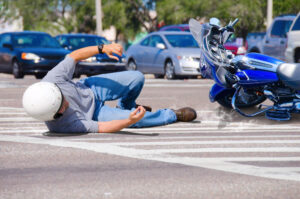Motorcyclists enjoy the experience of riding motorcycles, but they present certain safety risks that are unique to these vehicles. While their open nature might give their riders a sense of freedom, it also makes motorcyclists and passengers more vulnerable to serious and fatal injuries. However, it’s possible to improve the safety of these vehicles by taking the correct measures as either a motorcyclist or another driver on the road.
Learn about whether motorcycles can be safe and how you can improve motorcycle safety. Or get legal help from motorcycle accident lawyer.
How Dangerous Are Motorcycles?
Motorcycles are enjoyable for many riders but are often dangerous to operate and maneuver. According to data from the National Highway Traffic Safety Administration (NHTSA), over 5,000 motorcyclist fatalities occur annually. In addition, the Insurance Information Institute concluded that the risk of motorcyclists dying in an accident is 29 times higher than that of occupants in passenger vehicles per mile driven.
One of the main reasons for many fatalities is the lack of safety devices protecting motorcyclists, while cars and other vehicles offer an enclosure along with features such as airbags and seatbelts.
In addition to insufficient safety features, the motorcyclist’s competence and skill level could impact motorcycle safety. Riders must undergo enough education to learn how to properly and safely maneuver motorcycles through traffic. They should also gain experience handling motorcycles in normal traffic before operating them in more challenging settings.
Other motorists may also put motorcyclists at risk of serious injury on the road. Drivers must take extra care to watch for motorcycles on the road and maintain a safe distance between them while obeying other basic traffic safety rules and laws.
What Causes Motorcycle Accidents?
There are many potential causes of motorcycle accidents. Some examples of hazards that can lead to accidents involving motorcyclists include the following:
Speeding
Speeding is a common cause of motorcycle accidents. Speeding could involve a motorcyclist or another motorist on the road exceeding the posted speed limit and getting into an accident. In many cases, speeding accidents result because motorists don’t have enough time to come to a complete stop when needed. The increased speed can also increase the impact of a crash, causing debilitating and life-threatening injuries, especially to motorcyclists without the safety features of larger vehicles.
Poor Road Conditions
Another safety risk motorcyclists may face on the road includes unsafe road conditions. This could include everything from icy roadways to potholes that cause motorcyclists to lose control of their vehicles and crash. In many cases, poor road conditions may be the fault of certain governments that fail to maintain roadways in their jurisdictions. Maintenance crews could also be liable if they leave equipment or construction supplies behind and neglect to warn motorists with proper signage.
Blind Spots
All drivers have blind spots that they need to be aware of while on the road. Before changing lanes or making turns, motorists should check their blind spots to ensure no motorcycles or other vehicles are at risk of a collision. However, motorcycles are smaller than other vehicles, making it harder for other drivers to see them when checking their blind spots. As a result, motorists may crash into motorcycles if they neglect to ensure their path of travel is clear.
Tailgating
Vehicles that follow too closely behind motorcyclists could get into an accident. Motorists must maintain a greater distance between their vehicles and motorcycles to prevent rear-end accidents. This extra space gives rear vehicles more time to stop if they need to, which is critical, seeing as even low-impact rear-end accidents could cause serious motorcycle accidents.
Distracted Driving
Distracted driving could lead to motorcycle accidents if drivers fail to pay attention to the road and their surroundings.
According to the Centers for Disease Control and Prevention (CDC), distracted driving includes:
- Visual distractions that take drivers’ eyes away from the road.
- Physical distractions lead drivers to remove their hands from the steering wheel.
- Cognitive distractions reduce drivers’ awareness of their surroundings.
Some specific examples of distracted driving that can lead to motorcycle accidents include:
- Talking with passengers
- Eating while driving
- Texting or calling on a cell phone
- Rubbernecking, including looking at billboards or other potential distractions on the side of the road
- Engaging with the dashboard, including changing radio stations
Impaired Driving
 Driving under the influence of drugs or alcohol can lead to serious accidents, whether perpetrated by a motorcyclist or another motorist. Impaired driving can lead to decreased reaction times, awareness, and impaired judgment. As a result, the risk of getting into an accident will increase significantly.
Driving under the influence of drugs or alcohol can lead to serious accidents, whether perpetrated by a motorcyclist or another motorist. Impaired driving can lead to decreased reaction times, awareness, and impaired judgment. As a result, the risk of getting into an accident will increase significantly.
The legal limit in the U.S. for driving under the influence of alcohol is a blood alcohol concentration (BAC) of 0.08 percent, but certain states may also have their own “zero tolerance” policies with a lower limit. For instance, some states may consider a BAC of as low as 0.02 percent to constitute a DUI, particularly for underage drinkers and truck drivers.
Features That Can Improve Motorcycle Safety
While there are many ways motorcyclists can get into accidents on the road, some safety features can help reduce the risk of accidents. The following are some of the various safety features on motorcycles:
Traction Control
Motorcycles today feature optimal traction control in many designs to create more friction between the tires and the road. This traction control makes the motorcycle safer to operate on many surfaces that could otherwise cause the motorcycle to lose control. Specifically, traction control systems work through sensors that detect the traction on a given surface and adjust the power in the rear wheel accordingly.
Anti-Lock Braking Capabilities
One of the biggest issues affecting motorcycle safety is brake locking, which can cause the wheels to lock into place when motorcyclists attempt to stop or slow the vehicle. Anti-lock braking systems (ABSs) help to prevent wheels from locking up, which helps maintain stability and reduces the risk of drifts and skids on the roadway.
Automatically Adjusting Headlights
Like other vehicles, motorcycles today often feature adaptive headlights that automatically adjust based on the level of visibility on the roadway. If it’s too dark to see clearly or the motorcycle makes a sharp turn, and the motorcyclist can’t see clearly into the turn, there’s a greater risk of an accident.
Not only do adaptive headlights help transition between high and low beams depending on visibility, but they can also move in the direction of a turn to illuminate dark corners when making sharp turns around street corners. Changes in the vehicle’s elevation, speed, and steering often activate these headlights.
Automatic Gear Shifting and Clutches
Unlike other types of vehicles, motorcycles often feature gear shifts and clutches. It can take motorcyclists some time to get used to these systems if they’re unfamiliar with them. Because of their inexperience, motorcyclists may neglect to use their clutch or gear shift when appropriate, increasing the risk of an accident.
Many motorcycles feature automatic clutch and gear shift systems to help ensure motorcycles adjust the clutch and gear shifts as needed. These systems eliminate the need for riders to remember when to change each component.
Safety Gear That Bikers Can Wear to Avoid Injuries
Besides safety features on the motorcycle, motorcyclists can wear certain types of protective gear to further increase safety on the road. There are plenty of pieces of safety gear that bikers can wear to protect them from injuries in an accident, such as:
Helmets
Every motorcyclist should wear a helmet to provide additional protection for the head in the event of an accident. Helmets absorb some of the impact in an accident to help prevent head injuries, including traumatic brain injuries (TBIs). Some models also include face protection to prevent lacerations and other facial injuries in an accident.
Many states require riders to wear helmets.
Gloves
Riders also benefit from wearing gloves that can prevent serious hand injuries. In an accident, many motorcyclists will likely attempt to brace for impact by putting their hands out in front, which can lead to deep cuts and other hand injuries. Gloves help prevent these injuries. To maximize the protection gloves offer, they should be the right fit for each rider.
Gloves can also help protect the hands from harsh rain, sleet, and other weather elements while riding, and they may extend to the wrist. Some glove designs also feature padding to protect the palms, fingers, and knuckles.
Other Safety Gear
In addition to gloves, jackets, and helmets, motorcyclists can invest in other safety gear to provide more support and protection while riding.
For instance, some stores sell:
- Back protectors and back protector inserts
- Knee armor and knee guards
- Elbow armor
- Hip armor
- Shoulder armor
- Shin guards
- Impact pants and shorts
- Airbag vests
How Other Drivers Can Improve Safety for Motorcyclists?
Motorcyclists can travel safely on the roads with adequate safety features and gear, but it’s equally important for other motorists to practice safe driving habits to prevent motorcycle accidents.
Drivers can take these steps to increase the safety of operating a motorcycle:
- Give motorcyclists more space. Motorists should give ample space for motorcyclists to maneuver their vehicles on the road. Doing so will give motorists more time to stop to avoid a collision with motorcycles in front of them, which is critical considering that even low-impact accidents can seriously or fatally injure riders.
- Avoid distractions. Drivers can also maintain safer roads for motorcyclists by avoiding potential distractions while driving. These distractions may include texting and driving or looking at objects away from the road. Remaining aware of surroundings and focusing on the road will help minimize the risk of distracted driving accidents.
- Watch blind spots. Before turning, changing lanes, or reversing the vehicle, drivers should check their blind spots for motorcycles and other vehicles. Additionally, drivers should use their turn signals to indicate to others when they’re preparing to make a turn or change lanes.
- Avoid driving while impaired. Even a small amount of alcohol or other intoxicating substances could significantly reduce reaction times and impair judgment, putting the intoxicated driver and others at risk of a serious accident. If drivers cannot operate a vehicle safely, they should seek other means of transportation or stay in place until they are sober enough to operate their vehicles.
- Don’t drive while tired. Fatigued driving could also lead to an accident for some of the same reasons as impaired driving. Fatigued drivers won’t be able to react in time to hazards on the road or the actions of other drivers, and they may even fall asleep at the wheel. It’s best to avoid driving until you’ve gotten sufficient rest to help you maintain awareness while driving.
- Don’t pass the speed limit. Drivers should always adhere to posted speed limits and slow down as needed. If you don’t know what the speed limit is in your area, it’s best to travel around the same speed as other traffic. It’s also important to drive slower in certain weather conditions, such as when it’s raining heavily or the road is icy.

Andrew Finkelstein, Car Accident Lawyer in New York
Contact a Motorcycle Accident Lawyer to Discuss a Case After a Collision
While the proper safety measures and equipment can help reduce the risk of motorcycle accidents, these accidents can still occur. If a motorcycle accident occurs and you or a loved one sustains injuries, you may recover compensation from negligent parties responsible.
In these cases, consult with the best personal injury law firm in New York to discuss a potential claim. An attorney can collect evidence and help negotiate with insurers to recover the maximum compensation that motorcycle accident victims deserve.
